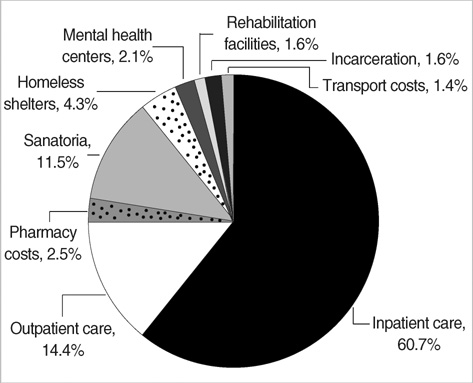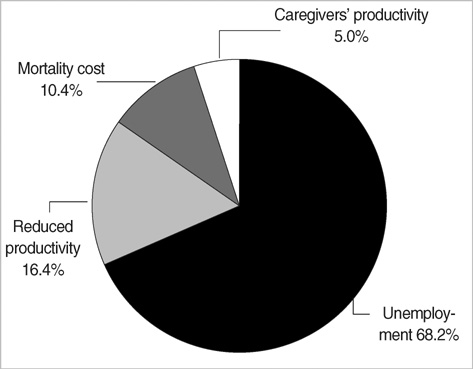Economic Burden of Schizophrenia in South Korea
- Affiliations
-
- 1Department of Psychiatry and Behavioral Science, Institute of Human Behavioral Medicine, Seoul National University College of Medicine, Seoul, Korea. mjcho@plaza.snu.ac.kr
- 2Department of Psychiatry, Gachon Medical School, Incheon, Korea.
- 3Department of Psychiatry, Office of Medical Education, Institute of Human Behavioral Medicine, Seoul National University College of Medicine, Seoul, Korea.
- 4Department of Psychiatry, Kangwon National University College of Medicine, Chunchon, Korea.
- 5Department of Psychiatry, Kyungpook National University School of Medicine, Daegu, Korea.
- KMID: 1713445
- DOI: http://doi.org/10.3346/jkms.2008.23.2.167
Abstract
- This study estimates the treated prevalence of schizophrenia and the annual costs associated with the illness in Korea in 2005, from a societal perspective. Annual direct healthcare costs associated with schizophrenia were estimated from National Health Insurance and Medical Aid records. Annual direct non-healthcare costs were estimated for incarceration, transport, community mental health centers, and institutions related to schizophrenia. Annual indirect costs were estimated for the following components of productivity loss due to illness: unemployment, reduced productivity, premature mortality, and caregivers' productivity loss using a human capital approach based on market wages. All costs were adjusted to 2005 levels using the healthcare component of the Consumer Price Index. The treated prevalence of schizophrenia in 2005 was 0.4% of the Korean population. The overall cost of schizophrenia was estimated to be $ 3,174.8 million (3,251.0 billion Won), which included a direct healthcare cost of $ 418.7 million (428.6 billion Won). Total direct non-healthcare costs were estimated to be $ 121 million (123.9 billion Won), and total indirect costs were estimated at $ 2,635.1 million (2,698.3 billion Won). Unemployment was identified as the largest component of overall cost. These findings demonstrate that schizophrenia is not rare, and that represents a substantial economic burden.
Keyword
MeSH Terms
Figure
Cited by 5 articles
-
A Study of Total Medical Cost and Hospitalization Risk of Patients with Schizophrenia and Type 1 Diabetes Mellitus
Sang-Uk Lee, You-Seok Kim
Korean J Schizophr Res. 2019;22(1):8-13. doi: 10.16946/kjsr.2019.22.1.8.Effects of Self-Assertive Training Applying Reality Therapy Techniques on Self-esteem and Internalized Stigma in Schizophrenia Patients
Na-Ra Kim, Mi Heui Jang
J Korean Acad Psychiatr Ment Health Nurs. 2019;28(1):37-49. doi: 10.12934/jkpmhn.2019.28.1.37.How Much Amount of Socioeconomic Loss Is Caused by Digestive Diseases?
Kyung Sik Park
Korean J Gastroenterol. 2011;58(6):297-299. doi: 10.4166/kjg.2011.58.6.297.Health Care Costs of Digestive Diseases in Korea
Hye-kyung Jung, BoHyoung Jang, Youn Hee Kim, JooYeon Park, Sun Young Park, Mi-Hee Nam, Myung-Gyu Choi
Korean J Gastroenterol. 2011;58(6):323-331. doi: 10.4166/kjg.2011.58.6.323.Symptom Remission Related to Increased Drug Response after Conversion Into Schizophrenia in Early Psychosis: A Case Report
Jung Hoon Kim, Jong-Ik Park
Korean J Schizophr Res. 2016;19(2):89-93. doi: 10.16946/kjsr.2016.19.2.89.
Reference
-
1. Mental and neurological disorders. Fact sheet no. 265. 199. World Health Organization;Available from: http://www.who.int/whr/2001/media_centre/en/whr01_fact_sheet1_en.pdf.2. Kessler RC, McGonagle KA, Zhao S, Nelson CB, Hughes M, Eshleman S, Wittchen HU, Kendler KS. Lifetime and 12-month prevalence of DSM-III-R psychiatric disorders in the United States. Results from the National Comorbidity Survey. Arch Gen Psychiatry. 1994. 51:8–19.3. Cho SJ, Cho MJ, Suh T, Hahm BJ, Hong JP, Bae JN, Lee JY, Lee DW, Park JI, Jeon HJ, Kim SJ, Kim YI. Prevalence rates of major mental disorders in mental health related facilities: nationwide 20 institutions study. J Korean Neuropsychiatr Assoc. 2004. 43:749–759.4. Wu EQ, Birnbaum HG, Shi L, Ball DE, Kessler RC, Moulis M, Aggarwal J. The economic burden of schizophrenia in the United States in 2002. J Clin Psychiatry. 2005. 66:1122–1129.5. Knapp M, Mangalore R, Simon J. The global costs of schizophrenia. Schizophr Bull. 2004. 30:279–293.
Article6. Park JI, Song SH, Suh Tw, Jang HJ, Lee JG, Chang AK, Kim Y, Lee C, Hong JP. Direct and indirect cost of treating out-patients with schizophrenia in Korea. J Korean Neuropsychiatr Assoc. 2000. 39:580–588.
Article7. Statistical Information System. National Health Insurance Corporation 2007 April cited. National Health Insurance Corporation;Available from: http://www.nhic.or.kr/wbm/wbmb/wbmb_1000_f.jsp .8. Health Insurance Review Agency, National Health Insurance Corporation. 2005 National Health Insurance Statistical Yearbook. Seoul, Korea: Health Insurance Review Agency and National Health Insurance Corporation 2006.9. Ministry of Health and Welfare, National Health Insurance Corporation. 2005 Medical Aid statistical Yearbook. Seoul Korea: Ministry of Health and welfare and National Health Insurance Corporation 2006.10. Korean Statistical Information System. Korean National Stastical Office 2007 April cited. Korean National Statistical Office;Available from: http://kosis.nso.go.kr/ .11. Bonta J, Law M, Hanson K. The prediction of criminal and violent recidivism among mentally disordered offenders: a meta-analysis. Psychol Bull. 1998. 123:123–142.12. National Budget and Settlement of Accounts Information System. The National Assembly of the Republic of Korea 2007 April cited. The National Assembly of the Republic of Korea;Available from: http://nafs.assembly.go.kr:83/ .
Article13. Jeong PJ. A study on the cure-custody system for mentally disordered offenders. 2004. Kongju: Kongju National University.14. Suh TW, Cho MJ, Kim JH, Kwak YS, Kim KK, Bae A, Kim DH. 2005 The Central Mental Health Supporting Committee Report. Ministry of Health and Welfare, Korean Institute for Health and Social Affairs, Central Mental Health Supporting Committee 2006.15. Statistical Data; statistics of homeless shelter Ministry of Health and Welfare. 2007 April cited. Ministry of Health and Welfare;Available from: http://www.mohw.go.kr/ .16. Kim MS. Development of a standardized operation fee model for social welfare facilities. Health and welfare policy forum. 2003. 84:88–101.17. Hong JP, Kim CY. Course and Outcome of Schizophrenia. Korean J Psychopathol. 1999. 8:140–150.18. Ministry of Health and Welfare, Korea Institute for Health and Social Affairs. 2005 Survey report on the disabled. 2006. Ministry of Health and Welfare, Korea Institute for Health and Social Affairs.19. 2005 Survey Report on Wage Structure. Ministry of Labor 2007 April cited. Labor Statistics of Korea;Available from: http://laborstat.molab.go.kr .20. Goeree R, O'Brien BJ, Blackhouse G, Agro K, Goering P. The valuation of productivity costs due to premature mortality: a comparison of the human-capital and friction-cost methods for schizophrenia. Can J Psychiatry. 1999. 44:455–63.21. Goeree R, Farahati F, Burke N, Blackhouse G, O'Reilly D, Pyne J, Tarride JE. The Economic Burden of Schizophrenia in Canada in 2004. Curr Med Res Opin. 2005. 21:2017–2028.
Article21. Murray RM, Jones PB, Susser E, Van Os J, Cannon M. The epidemiology of schizophrenia. 2003. New York: Cambridge University Press.
Article22. Goeree R, Farahati F, Burke N, Blackhouse G, O'Reilly D, Pyne J, Tarride JE. The economic burden of schizophrenia in Canada in 2004. Curr Med Res Opin. 2005. 21:2017–28.
Article23. Jeong HS. Public financing in total health expenditure and coverage by National Health Insurance in Korea: including comparison with other OECD countries. Korean J Health Economics Policy. 2004. 10:95.24. Bijl RV, Ravelli A, van Zessen G. Prevalence of psychiatric disorder in the general population: results of The Netherlands Mental Health Survey and Incidence Study (NEMESIS). Soc Psychiatry Psychiatr Epidemiol. 1998. 33:587–595.
Article25. Cho MJ, Kim JK, Jeon HJ, Suh T, Chung IW, Hong JP, Bae JN, Lee DW, Park JI, Cho SJ, Lee CK, Hahm BJ. Lifetime and 12-month prevalence of DSM-IV psychiatric disorders among Korean adults. J Nerv Ment Dis. 2007. 195:203–210.
Article26. Andrews G. The cost of schizophrenia revisited. Schizophr Bull. 1991. 17:389–394.
Article27. Knapp M, Chisholm D, Leese M, Amaddeo F, Tansella M, Schene A, Thornicroft G, Vazquez-Barquero JL, Knudsen HC, Becker T. Comparing patterns and costs of schizophrenia care in five European countries: the EPSILON study. European Psychiatric Services: Inputs Linked to Outcome Domains and Needs. Acta Psychiatr Scand. 2002. 105:42–54.28. DeFrances CJ, Hall MJ, Podgornik MN. Advance data from vital and health statistics; no 359. 2005, 2003. Hyattsville, MD: National Center for Health Statistics.29. Australian Institute of Health and Welfare (AIHW). Australian hospital statistics 2001-02. 2003. Canberra: AIHW;Health Services Series no. 20. AIHW cat. no. HSE 25.30. Department of Health. Hospital Episode Statistics, Department of Health, England, 2002-03.
- Full Text Links
- Actions
-
Cited
- CITED
-
- Close
- Share
- Similar articles
-
- Caregiver Burden in Schizophrenia and Autism Spectrum Disorders: A Comparative Study
- Epidemiology and Economic Burden of Osteoporosis in South Korea
- Health Economic Approach on Mental Health in Korea
- Economic Burden of Heart Failure in Asian Countries with Different Healthcare Systems
- Adherence to Antipsychotic Drugs by Medication Possession Ratio for Schizophrenia and Similar Psychotic Disorders in the Republic of Korea: A Retrospective Cohort Study



